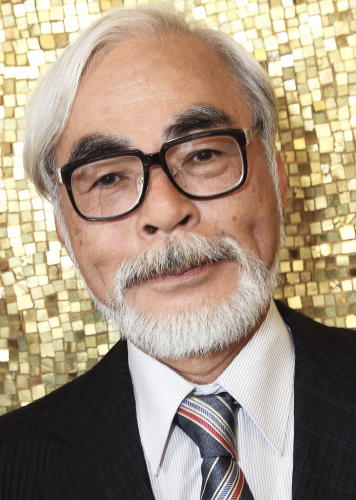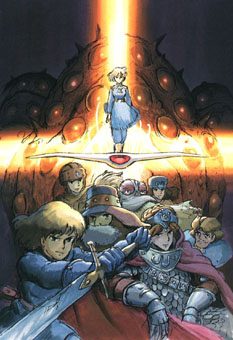
Hayao Miyazaki was born in Tokyo on January 5, 1941. He started his career in 1963 as an animator at the studio Toei Douga, and was subsequently involved in many classics of Japanese animation. He was known for his incredible ability to draw, and the seemingly endless stream of movie ideas he proposed. In 1971, he moved to A Pro with Isao Takahata, then to Nippon Animation in 1973, where he was heavily involved in the World Masterpieces Theatre TV animation series for the next five years. In 1978, he directed his first TV series, Conan, The Boy in Future, then moved to Tokyo Movie Shinsha in 1979 to direct his first movie, the classic Lupin III: The Castle of Cagliostro. In 1984, he released Nausicaä of the Valley of the Wind, based on the manga (comic) of the same title he had started two years before. The success of the film led to the establishment of a new animation studio, Studio Ghibli, and which Miyazaki has since directed, written, and produced many other films with Takahata. All of these film were critical and box office successes. In particular, Miyazaki's Princess Mononoke reeived the Japan Academy Award for Best Film and was the highest-grossing (about US $150 million) domestic film in Japan's history until it was taking over by another Miyazaki's work, Spirited Away.

Nausicaä of the Valley of the Wind is about a young princess of a small nation, who live in a world devastated by a holocaust called the "Seven Days of Fire." She gets involved in a struggle with Tolmekia, a kingdom who tries to use an ancient weapon to fend off the Ohms. She must stop the Tolmekians from killing these insects and stop the other warring nations from destroying themselves and from destroying the any means by which their world can be saved from the spread of polluted wastelands.
In the movie, Nausicaä is a very strong girl. After her father passed away, she took on the role as the sole leader for her nation. She is not your every day princess. She even have her own laboratory under her palace where she conduct her own research on poisonous plants and spores that she collected on her own. She found a solution as to how to save these plants. She was very strong willed, doing whatever it takes to save the Ohms, even if it is to sacrifice herself.
Miyazaki uses many style and themes for his movies, including environmentalism and feminism, among others. Miyazaki often emphasizes Earth's fragility, especially in the context of critiquing development and pollution. It is shown through almost all of his movies, Nausicaä of the Valley of the Wind and Princess Mononoke, being the two main ones. In each film, the conflict between the natural way of life and the military destruction of culture, land and resources is central to the plight of the protagonists. When battle scenes are shown in each, the militaristic music and ecological destruction is paramount to the endangerment of the inhabitants of the villages. In an interview with The New Yorker, Miyazaki claimed that must of the modern culture is "thin and shallow and fake", and "not entirely jokingly" looked forward to an apocalyptic age in which "wild green grasses" take over.
All of Miyazaki's films are populated by strong female protagonists that go against gender roles common in Japanese animation and fiction. Miyazaki has been called a feminist by Studio Ghibli President Toshio Suzuki. He said, "[Miyazaki] have this conviction that to be successful, companies have to make it possible for their female employees to succeed too. You can see this attitude in Princess Mononoke. All characters working the bellows in the iron works are women. Then there's Porco Rosso. Porco's plane is rebuilt entirely by women."
Bell Hooks said that she realized that her students "learned more about race, sex, and class from movies than from all the theoretical literature [she] was urging them to read" (2) was very true. Miyazaki gave the same notion stating that he is very worried about kids consuming too much media. He also said that he hates the idea that children watch his films repeatedly.
My painting that was inspired by Hayao Miyazaki. This painting did show up on my first post.

Sources:
Toshio Suzuki's notion is from Birth of Studio Ghibli on Nausicaä DVD
Bell Hook's Making Movie Magic
I love all of Miyazaki's works because the way he draw the world. He likes to go to beautiful places and often use those places in his works. Like Princess Mononoke, he was inspired by Yakushima in Kagoshima-prefecture. Here is a youtube link you can view.
ReplyDeleteI believe that he is a feminist. I didn't notice until you mentioned this, but it is obvious. I think only the man who are drawn to be "cool" is Ashitaka from Princess Mononoke. Other men characters Miyazaki draws are not main, but sometimes help the female main characters.
And please don't forget about Joe Hisaishi who is a composer who offered his music for Ghibli movies. Miyazaki was saying that if there was no Hisaishi's music in his movies, he could not be this famous director. (it is off-topic though..)
I love Joe Hisaishi!
ReplyDeleteI've been a fan of Hayao Miyazaki for about a few months, and its nice to see that others know of him and appreciate his work. I absolutely agree that Miyazaki is a feminist, although I have never really heard him voice it out, it is evident through his work, which are truly stunning masterpieces. His feminist style of directing is something I noticed only recently while taking this class, I feel I've become more aware of subtleties that revolve around gender related issues. While watching Miyazaki's movie Spirited Away, I noticed how carefully he weaves the main character, usually a female, into a protagonist role normally dominated by men, he does this so fluidly that the audience is so caught up into the actual content of the story that gender is overlooked, this was the case for me. Although Spirited Away was the first Miyazaki Film I've seen and also my favorite, Howls Moving Castle is a close second. Those two in particular cater slightly more to my taste in films, but I have seen his other movies all of which are amazing.
ReplyDeleteI really didn't notice the female protagonists till you pointed them out! Usually when I think Miyazaki, I just think awesome anime movies with amazing characters in a fantasy land. Which can also be mis-interrupted as, these girls really don't exist. However, the main factor of positive movement is they ARE female, realistic or just a fantasy, everyone is identifying with a girl.
ReplyDelete